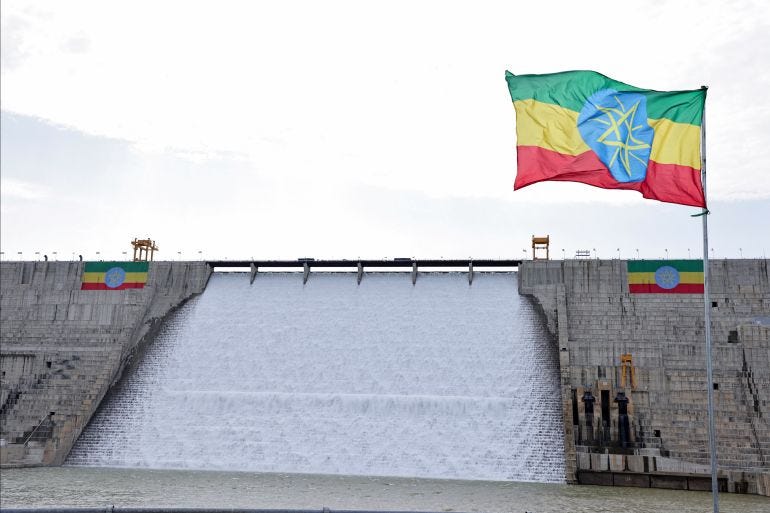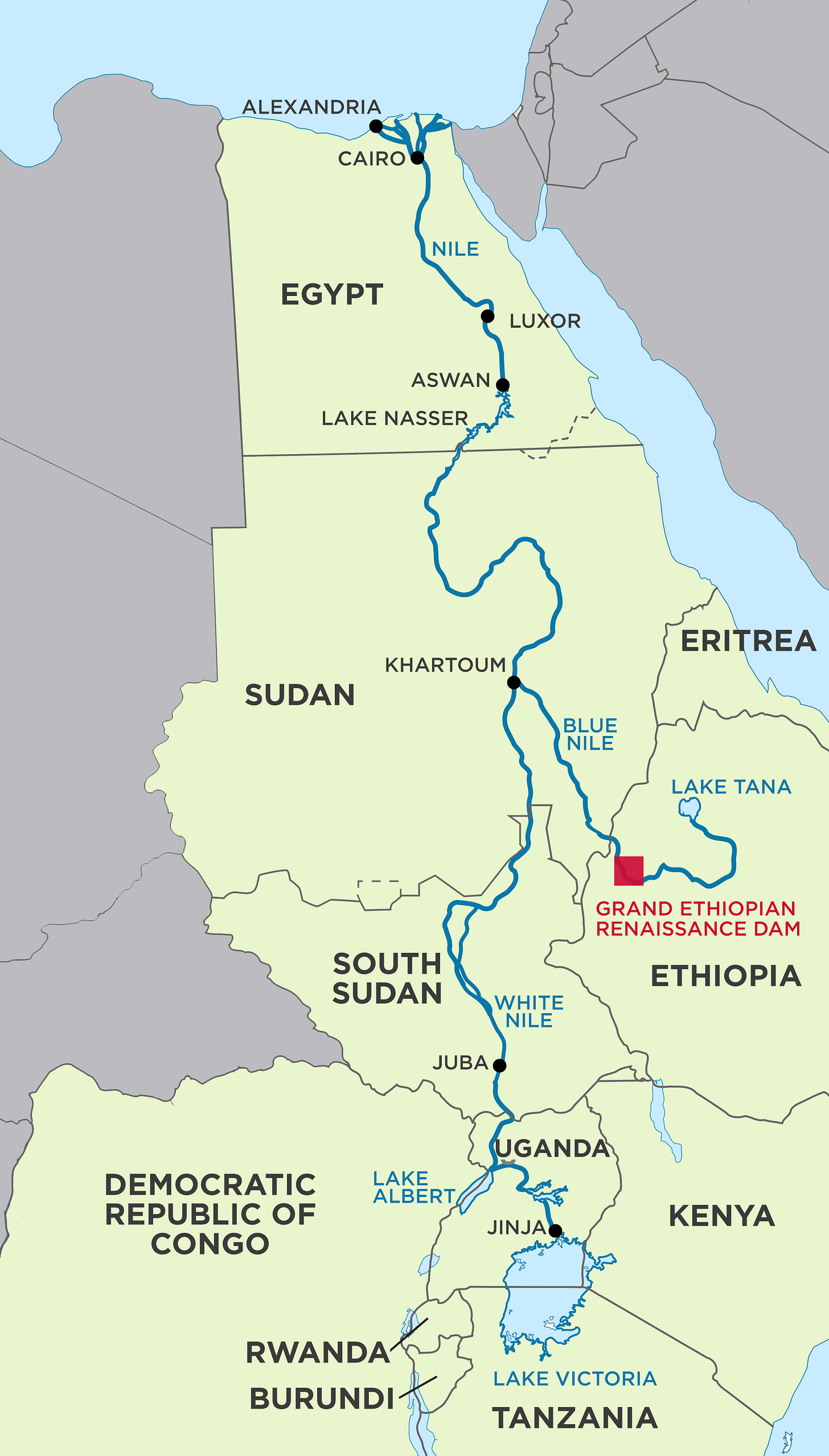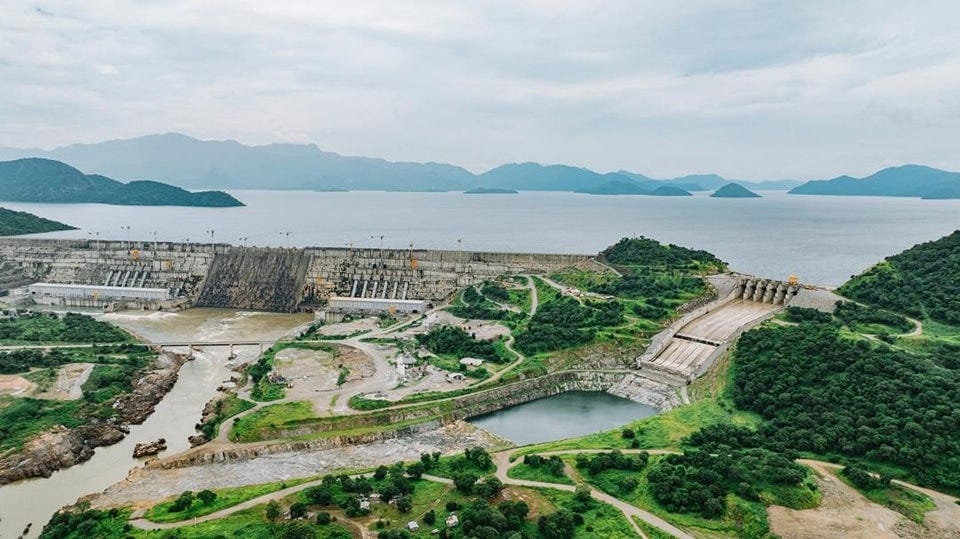The GERD Gambit
How the mega-dam in Ethiopia might threaten its Nile neighbours, and what it means for Ethiopia's energy independence.
As an erstwhile player of Europa Universalis IV (EU4), a historical grand strategy simulator, I’ve always had a soft spot for Ethiopia. In EU4, which begins from 1444, Ethiopia starts in a precarious situation. It lives in the shadow of the Mamluks, the predecessor of modern-day Egypt, and contends with unruly subjects, Medri Bahri (modern-day Eritrea) and Damot (situated roughly in the Tigray region).
As history would have it, the regional geopolitics of modern Ethiopia has not changed much. One of Ethiopia’s persistent thorn in its side is Egypt. Egypt has long-standing ties with the Tigray People’s Liberation Front (TPLF), an ethnic-nationalist, paramilitary group which sparked a vicious civil war in Ethiopia that left more than half a million dead. More recently, Egypt has also started to deploy military troops in Somalia, for “peacekeeping purposes”. This defence pact is likely driven by what it perceives as two existential threats: the first being a recent memorandum signed between Ethiopia and Somaliland (a breakaway, unrecognised state from Somalia) granting extensive port rights to the Red Sea coast. The second threat is likely the construction of Ethiopia’s new mega-dam, which has the power to significantly curtail the water that Egypt receives from the Nile.
Damming relations
The Nile has two major tributaries: the White Nile and the Blue Nile. While the former is longer and traditionally considered the geographical beginning of the Nile, the Blue Nile contributes 60-80% of the water. It begins at Lake Tana in Ethiopia, and flows into Sudan from the southeast, and then into Egypt before draining into the Mediterranean Sea.
There is no doubt that controlling a major tributary of the Nile by a geopolitical rival puts Egypt in jeopardy: after all, more than 90% of Egypt’s freshwater needs are supplied by the river. A significant portion of Egyptian agriculture relies existentially on the Nile for irrigation. In an address to the UN Security Council, Egypt’s Minister of Foreign Affairs declared:
Any misguided assumptions that Cairo might turn a blind eye to its existential interests in the Nile are mere delusions… Egypt reserves its right to take all measures guaranteed by international law and the UN Charter to defend the existential interests of its people
Sudan is also dependent on the Nile — Khartoum, its capital, sits at the intersection between the Blue and White Nile. While the Grand Ethiopian Renaissance Dam (GERD) can potentially help with Sudan’s flood management (monsoon rains overflood the Blue and White Nile and bust the riverbanks), Sudan has traditionally sided with Egypt, which is a major backer of the national army in Sudan’s civil war.
Coase Theorem
But who actually owns the Nile? A colonial-era treaty brokered by the British Empire in 1929 afforded Egypt majority rights to the Nile and its tributaries by guaranteeing 48 billion cubic meters of Nile water. A 1959 agreement signed by Egypt and Sudan increased that amount to 55 billion.
However, in May 2010, five Nile basin countries – Uganda, Kenya, Tanzania, Ethiopia, and Rwanda – signed the Entebbe Agreement, declaring the 1929 and 1959 agreements were "void and invalid because they were written and ratified under British colonialism." Burundi and South Sudan became signatories in 2011 and 2013. In 2015, Egypt, Sudan and Ethiopia came together and signed the Declaration of Principles, which basically was a symbolic promise for the three nations to "not cause significant damage” and use the Nile in a “fair and appropriate manner”. Additionally, Ethiopia should also “apply the recommendations of international technical experts… during different stages of the dam project”.
At the end of the day, both parties lack a common legal framework that would bind them to a consensus. While the Entebbe Agreement is Ethiopia’s legal basis in building the GERD, it was not ratified by Egypt. To make its case, Egypt relies on a clause in the 1959 agreement which states that all members of the Nile River basin must ratify future agreements — hence the invalidity of the Entebbe Agreement. Yet, when both the 1929 treaty and 1959 agreement were signed, Ethiopia wasn’t present either.
A well-known problem in economics is externalities. The Coase theorem, attributed to Nobel Prize laureate Ronald Coase, states that in the presence of externalities, private parties can bargain amongst themselves to reach an economically efficient outcome, regardless of the initial allocation of property rights. Perhaps the solution is not negotiating through legal channels, but instead through resource deals. A 2014 study published by Islam Mamdouh, an Egyptian dam expert and a PhD holder from Kyushu University, agrees for Sudan:
The dam will prevent the yearly flooding of the Blue Nile, which often causes destruction in Sudan, and will also reserve water which would help in organising and facilitating the agricultural process in Sudanese land.
Ethiopia will only use 50 percent of the power generated from the dam and will offer Sudan 30 percent of the remaining power at lower than the international price.
Mamdouh also suggested that Egypt could be compensated by buying the remaining 20 percent for below market price. This is unlikely, as unlike Sudan, Ethiopia has no direct high-voltage transmission lines with Egypt. Building one would be a massive undertaking as well, requiring thousands of kilometers of cables. Moreover, no Egyptian government would never take such a deal — it would essentially be political suicide.
But are Egypt’s complains even valid? Downstream on the White Nile, is the Egyptian High Aswan Dam. Egypt claims that the GERD will reduce the volume of water of the Nile River to Sudan, and subsequently to the Aswan Dam. This did not happen; for the reason that the GERD is strictly a hydroelectric dam. This means that all the water passes through, providing a continuous flow of water downstream.
How effective is GERD, actually?
For Ethiopia, the GERD is a triumph. For a country rife with ethnic divisions, the GERD is probably the singular issue that can unite the country. After international institutions refuse to finance the project, Meles Zenawi, a former prime minister, called on everyday Ethiopians instead. Nearly every citizen became a stakeholder, through government-issued, low-denomination bonds.
All full capacity, the dam should be able to generate 5100MW of power, which is more than double of what Ethiopia produces without the dam. This is enough to supply tens of millions of homes throughout the country. Numbers vary, but it is estimated that half of Ethiopia’s 130 million people have access to electricity, and less than a quarter are connected to the national grid. At the current rate of expansion, Energy Minister Habtamu Ifeta’s goal of 90% access by 2030 is unlikely. Furthermore, droughts have impacted water levels, reducing its current output. On May 2025, the GERD was reportedly producing up to 1850MW out of its 5100MW capacity.
Even if the GERD can produce tons of cheap electricity, most of it ends up exported to neighbouring countries. Despite its energy deficit, Ethiopia sells electricity to Djibouti, Sudan and Kenya, earning some $100m a year currently. Prime Minister Abiy claims the dam will eventually generate $1bn annually in revenue. In 2022, Ethiopia signed a MoU with South Sudan to export 100MW of power over the next three years. Hence, it might be a little idealistic to assume the GERD will immediately uplift the lives of everyday Ethiopians. Transmission infrastructure within the country is still lacking, and it will take decades for a comprehensive system to be built.
Nonetheless — the GERD is truly an Ethiopian marvel. It is the largest hydroelectric dam in Africa, and the 17th largest in the world. Funded almost entirely by ordinary citizens, it is proof that for a continent rife with corruption and foreign dependence, Ethiopia can achieve progress through its own will and resources.





So interesting...
I was vaguely aware of this project, but the details and potential consequences are quite remarkable.
Fascinating analysis, Brian! Your EU4 reference is spot on - the historical continuity of these regional tensions is remarkable. The economic paradox you highlight is particularly striking: Ethiopia exports electricity while half its population lacks access. This mirrors a classic development economics dilemma where resource-rich nations prioritize export revenues over domestic welfare.
Your point about the Coase theorem is insightful, but I wonder if the power asymmetries here make bargaining solutions unlikely. Egypt's existential dependence on the Nile gives it strong incentives to use all available leverage - hence the TPLF support and Somalia deployment you mention.
The citizen-financed aspect is truly remarkable though. In an era where African infrastructure projects are often criticized as Chinese debt traps, GERD represents genuine homegrown development. Do you think this financing model could be replicated for other mega-projects across the continent?